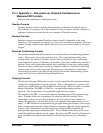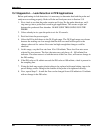
Appendices
January 2009 UDA2182 Universal Dual Analyzer Product Manual 227
15.14 Appendix M – Procedure for Low Level ppb Dissolved Oxygen
Testing
Overview
The purpose of this procedure is two-fold. First, using a controlled environment, new
probes and/or analyzers can be tested to determine if each is performing correctly before
being installed in the field. Second, this procedure can be used to re-test the performance
of an existing analyzer and/or probe.
You may choose to use this set-up for a zero calibration test. However, a zero calibration
test would require, as a minimum, modifications to two of the test parameters. One
modification would require a closed loop water system. The sample water must be
tapped directly from the customer’s process water. The other modification would be the
gas. For zero calibration, a high purity nitrogen gas (very expensive) must be piped into
the process sample. Since Honeywell can neither control the quality of the gas the
customer purchases nor the quality of the process water used, the company will not
guarantee the accuracy of the results of a zero calibration done by this modified method.
Equipment Needed
• One Tank of Oxygen in Nitrogen gas mixture
• One pressure regulator/shutoff valve
• Wash bottle - used to add moisture to the sample gas before the gas reaches the
probe. (Without addition of moisture, the Nitrogen gas would dry out the probe
membrane.)
• One Beaker - used to vent the gas sample
• One Dissolved Oxygen probe - used to make DO measurement
• One Dissolved Oxygen flow through chamber - provide a closed environment
• One Honeywell Model UDA2182 Analyzer - monitors and displays DO value.
Oxygen Measurement Procedure
1. Connect probe and energize the electronics.
2.
Allow probe to sit in tap water for 1 hour.
3.
Perform an air calibration per the manual instructions.
4.
Set-up equipment as shown in Figure 15-7.
5.
Install probe into sealed flow chamber and connect to wash bottle piping.
6.
Set room temperature to 25°C and sparge water with nitrogen overnight. Reading
should be less than 1 ppb.
7.
Remove probe from flow chamber and expose to 25°C air for 2 hours.
8.
Perform an air calibration.


















